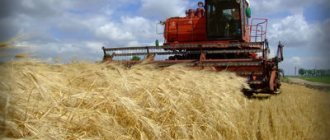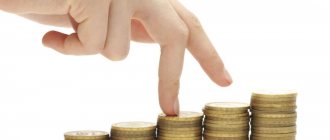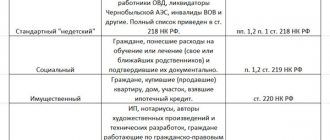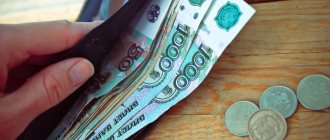Home / Taxes / What is VAT and when does it increase to 20 percent? / Rate and base
Back
Published: December 28, 2017
Reading time: 7 min
0
268
Entrepreneurs engaged in the catering industry or the sale of food products charge VAT on food products. When calculating VAT, suppliers apply different rates determined by the legislative acts of the Tax Code of the Russian Federation (hereinafter referred to as the Tax Code of the Russian Federation).
- VAT on food products at a rate of 10%
- VAT on food products at the rate of 18%
- VAT exemption
- Application of 0% rate
- Table of products with different VAT rates
- Results
This takes into account the circumstances and conditions in which the production and sale of certain food products is carried out.
VAT on food products at a rate of 10%
Food products subject to a VAT rate of 10% are included in a special list defined by subparagraph 1 of paragraph 2 of Article 164 of the Tax Code of the Russian Federation.
To confirm this rate, it is necessary that the name of the product is contained in the All-Russian Product Classifier (OKP) - for Russian products, or the Commodity Nomenclature of Foreign Economic Activity (TN VED) - for foreign ones (letter of the Ministry of Finance of Russia dated July 4, 2012 No. 03-07-08/167 ).
To confirm the 10% rate, you need to draw up a document that will certify that the product complies with all the conditions of technical regulations.
However, there are judicial precedents considering cases of refusal to confirm this rate (Resolutions of the Federal Antimonopoly Service of the North-Western District dated 02.28.2014 No. A56-9963/2013, FAS Moscow District dated 03.13.2008 No. KA-A40/1415-08).
The tax justification and the amount of tax calculated at a rate of 10% are indicated in line 020 (columns 3 and 5, respectively) of the VAT return (order of the Federal Tax Service of Russia dated October 29, 2014 No. ММВ-7-3 / [email protected] ).
Reduction of VAT on fruits and berries from 20% to 10%
HomeNewsLegislation Reduced VAT on fruits and berries
Decree of the Government of the Russian Federation of December 31, 2021 N 1952 put an end to the reduction of VAT from 20% to 10% on fruits and berries, including grapes. Fruits and berries (including grapes) has been added to the list of product codes subject to VAT of 10% in Decree of the Government of the Russian Federation of December 31, 2004 N 908 . This section is included both in the list of codes for types of food products in accordance with the All-Russian Classification of Products (OKP), and in the list of codes for types of food products in accordance with the Commodity Nomenclature of Foreign Economic Activity of the EAEU.
1. Section included in the list of product codes in accordance with OKP.
| Fruits and berries (including grapes) | |
| 01.13.21 | Watermelons |
| from 01.13.29 <*> | Melons |
| 01.21 | Grape |
| 01.22 <*> | Tropical and subtropical fruits (except bananas, including fresh plantains) |
| 01.23 | Citrus fruits |
| 01.24 | Fruits of pome and stone fruits |
| 01.25.1 | Berries and fruits of plants of the Vaccinium species |
| 01.25.2 | Fruit seeds |
| 01.25.9 | Other fruits of trees and shrubs, not included in other groups |
| 01.30.10.123 | Seedlings of berry crops |
| 01.30.10.130 | Fruit and berry crops, including cuttings and layering |
| 01.30.10.131 | Pome fruit crops |
| 01.30.10.132 | Stone fruit crops |
| 01.30.10.133 | Berry crops |
| 01.30.10.136 | Grapes (berry crop) |
| 01.30.10.139 | Other fruit and berry crops |
| 02.30.40.120 | Wild berries |
<*> For the purposes of applying this position, one should be guided by both the OK code 034-2014 and the name of the product.
2. Section included in the list of product codes in accordance with the unified Commodity Nomenclature of Foreign Economic Activity of the EAEU
Fruits and berries (including grapes)
| HS Code | Fruits and berries |
| Dates, figs, pineapples, avocados, guavas, mangoes and mangosteen, or garcinia, fresh | |
| from 0804100000 | fresh dates |
| 0804201000 | fresh figs |
| 0804300001 | fresh pineapples |
| from 0804400000 | fresh avocados |
| 0804500001 | fresh guava, mango and mangosteen, or garcinia |
| Citrus fruits, fresh | |
| 0805102000 | sweet oranges, fresh |
| 0805108000 | other oranges, fresh |
| 0805210000 | tangerines (including tangerines and satsumas), fresh |
| 0805220000 | fresh clementines |
| 0805290000 | Wilkings and similar citrus hybrids, fresh |
| 0805400000 | grapefruits, including pomelo, fresh |
| from 080550 | lemons (Citrus limon, Citrus limonum) and limes (Citrus aurantifolia, Citrus latifolia), fresh |
| from 0805900000 | other citrus fruits, fresh |
| Grape | |
| 080610 | fresh grapes |
| Watermelons, melons and papaya, fresh | |
| 0807110000 | fresh watermelons |
| 0807190000 | other fresh melons |
| 0807200000 | fresh papaya |
| Apples, pears and quinces, fresh | |
| 080810 | apples |
| 080830 | pears |
| 0808400000 | quince |
| Apricots, cherries and sweet cherries, peaches (including nectarines), plums, sloe, cherry plum (tkemali, cherry plum), fresh | |
| 0809100000 | fresh apricots |
| 0809210000 | sour cherry, or common cherry (PRUNUS CERASUS), fresh |
| 0809290000 | sour cherry (PRUNUS CERASUS), other |
| 0809301000 | fresh nectarines |
| 0809309000 | other fresh peaches |
| 0809400500 | fresh plums |
| 0809409000 | fresh sloe |
| Strawberries (strawberries), raspberries, blackberries, black, white or red currants, gooseberries, cranberries, blueberries and other berries of the genus Vaccinium, kiwi, persimmon, barberry, dogwood, pomegranate, feijoa, medlar, other fruits, wild berries, fresh | |
| 0810100000 | strawberries (strawberries) fresh |
| 0810201000 | fresh raspberries |
| from 0810209000 | fresh blackberries |
| 081030 | black, white or red currants and gooseberries |
| 081040 | cranberries, blueberries and other berries of the genus Vaccinium |
| 0810500000 | kiwi |
| 0810600000 | durian |
| 0810700000 | persimmon |
| 0810902000 | tamarind, cashew, lychee, jackfruit, sapodilla, passionflower, carambola and pitaya |
| from 0810907500 | barberry, dogwood, pomegranate, feijoa, medlar, other fruits, fresh |
| from 0810 | wild berries, fresh |
| Seeds, seedlings, roots, cuttings and layerings of fruit and berry crops (including grapes) | |
| from 0602 | roots, cuttings and layering of fruit trees (including grapes), shrubs, shrubs, seeds and seedlings of berry crops |
| out of 1209 | fruit tree seeds |
The law applies to all trade relations starting from October 1.
Before the changes were made, the application of a 10% tax was risky, since there were no names and codes of types of fruits and berries in the list of OKP and in the list of HS. Now all market participants can be sure that VAT on these fruits and berries will be 10%.
Please note that bananas are not included in the list; in addition, the 10% VAT rate no longer applies to palm oil.
Recommended articles:
- VAT when paying customs duties
- Customs clearance of fruits and vegetables
VAT on food products at the rate of 18%
For other food products not included in the list of clause 2 of Article 164 of the Tax Code of the Russian Federation, a rate of 18% is assigned (clause 3 of Article 164 of the Tax Code of the Russian Federation). The same rate is assigned in circumstances where the supplier cannot document the right to set a 10% rate.
When drawing up a VAT return, the amounts received from the sale of food products at a rate of 18%, and the VAT itself, are reflected in section 3 (line 010, in columns 3 and 5).
New tax for agricultural producers
Since 2021, the norm of Article 346.1 (3) of the Tax Code of the Russian Federation, according to which payers of the Unified Agricultural Tax were exempt from paying value added tax (except for import tax), has ceased to apply.
This means that the Unified Agricultural Tax requires:
- charge VAT on the sale of goods, works, services and upon receipt of advances;
- within five days, transfer to buyers invoices with the allocated amount of value added tax;
- request invoices from suppliers to account for incoming VAT;
- exercise the necessary caution and caution when choosing a counterparty (so as not to be denied a deduction);
- maintain books of sales and purchases;
- submit your VAT return electronically every quarter;
- transfer VAT to the budget on time (in three equal installments no later than the 25th day of each of the three months following the reporting quarter).
Please note that the basic VAT tax rate has increased since 2021. Instead of 18% it is now 20%. However, for some food products a preferential rate of 10% is applied (Article 164 of the Tax Code of the Russian Federation).
This list includes the main products of agricultural producers:
- livestock and poultry in live weight;
- meat and meat products, with the exception of gourmet foods;
- milk and dairy products;
- eggs and egg products;
- vegetable oils, margarine, special purpose fats;
- sugar;
- grain, mixed feed, feed mixtures, grain waste;
- oilseeds and products of their processing;
- bread and bakery products;
- cereals, flour, pasta;
- live fish, with the exception of valuable species;
- seafood and fish products, except gourmet foods;
- products for baby and diabetic nutrition;
- vegetables.
VAT exemption
According to the provisions of the Tax Code of the Russian Federation, an exemption from VAT is applied when food products are made or sold in food outlets of educational and medical organizations.
This act is enshrined in subparagraph 5 of paragraph 2 of Article 149 of the Tax Code of the Russian Federation. To confirm this fact, the responsible person must present evidence or certificates that authorize the provision of medical or educational services (letter of the Ministry of Finance of the Russian Federation dated December 3, 2014 No. 03-07-15/61906).
The price of food products exempt from VAT is determined by code 1010232, section 7 of the VAT return.
If the production or sale of food products is subject to the simplified taxation system (STS), then VAT is also not charged. This norm is enshrined in the provisions of paragraph 2 of Article 346.11 of the Tax Code of the Russian Federation.
It becomes invalid in circumstances where food products are supplied to the Russian Federation, or the organization using the simplified tax system is an agent.
If an organization operates within the framework of UTII, then, according to paragraph 4 of Article 346.26 of the Tax Code of the Russian Federation, it is exempt from VAT charges. However, in this case it is necessary to comply with the requirements of subparagraphs 6–9 of paragraph 2 of Article 346.26.
List of goods subject to VAT at a rate of 10% in 2021
DairyNews has published a list of goods subject to VAT at a rate of 10% in 2021.
Last summer, the President of the Russian Federation signed a law increasing the basic VAT rate from 18% to 20%. At the same time, the existing VAT benefits in the form of an exemption from this tax are retained, as well as a reduced VAT rate of 10%, which applies to social goods (services), some food products, etc.
According to Consultant Plus, 10% VAT is applied on sales of the following categories:
- food products that are listed in paragraphs. 1 item 2 art. 164 Tax Code of the Russian Federation;
- products for children listed in paragraphs. 2 p. 2 art. 164 Tax Code of the Russian Federation. These include, but are not limited to, children's clothing and shoes, children's beds and mattresses, toys;
- periodicals and books related to education, science and culture. Periodical printed publications include any publications with a permanent name and current number that are published once a year or more often (newspapers, magazines, almanacs, bulletins, etc.) (clause 3, clause 2, article 164 of the Tax Code of the Russian Federation). In this case, to confirm the VAT rate of 10%, you must have a certificate issued by Rospechat (clause 2 of the Notes to the List of types of periodicals and book products, approved by Decree of the Government of the Russian Federation of January 23, 2003 N 41).
The list of medical goods that are subject to VAT at a rate of 10% is specified in paragraphs. 4 paragraphs 2 art. 164 Tax Code of the Russian Federation. These are goods of both domestic and foreign production:
- medicines (including medicines manufactured by pharmacy organizations);
- medical products (except those exempt from VAT).
Despite the fact that social food products are subject to a preferential VAT rate, there are a lot of non-tax factors that can increase consumer food prices.
A 10% VAT rate is applied according to current documents when selling the following food products:
- livestock and poultry in live weight; meat and meat products (with the exception of delicacies: tenderloins, veal, tongues, sausages - raw smoked premium, raw smoked semi-dry premium, dry-cured, stuffed premium; smoked pork, lamb, beef, veal, poultry - balyk, carbonate, necks, hams, pastrami, sirloin; baked pork and beef; canned food - ham, bacon, carbonade and jellied tongue);
- milk and dairy products (including ice cream produced on their basis, with the exception of ice cream produced on a fruit and berry basis, fruit and edible ice);
- eggs and egg products; vegetable oil; margarine, special-purpose fats, including cooking, confectionery, baking fats, milk fat substitutes, equivalents, improvers and substitutes for cocoa butter, spreads, melted mixtures;
- sugar, including raw sugar; salts;
- grain, mixed feed, feed mixtures, grain waste; oil seeds and products of their processing (meal(s), cake);
- bread and bakery products (including butter, crackers and bagels), cereals, flour, pasta;
- live fish (with the exception of valuable species: white fish, Baltic and Far Eastern salmon, sturgeon (beluga, bester, sturgeon, stellate sturgeon, sterlet), salmon, trout (except sea trout), nelma, chum salmon, chinook salmon, coho salmon, muksun, omul, whitefish Siberian and Amur, chir);
- seafood and fish products, including chilled, frozen and other types of processed fish, herring, canned food and preserves (with the exception of delicacies: sturgeon and salmon caviar; white fish, Baltic salmon, sturgeon fish - beluga, bester, sturgeon, stellate sturgeon, sterlet ; salmon; backs and sides of cold-salted nelma; chum salmon and chinook lightly salted, medium-salted and salted salmon; backs of chum salmon, chinook salmon and cold-salted coho salmon, sides of chum salmon and cold-salted chinook salmon; backs of muksun, omul, Siberian and Amur whitefish, cold-smoked chira; preserved fillets - slices of Baltic salmon and Far Eastern salmon; crab meat and sets of individual boiled-frozen crab limbs; lobsters);
- baby and diabetic food products;
- vegetables (including potatoes).
Application of 0% rate
When food products are sold abroad, it is possible to set a rate (clause 1 of Article 164 of the Tax Code of the Russian Federation). To confirm this fact, after 180 days from the time of customs registration, you must present the following documents:
- copies of agreements with counterparties;
- copies of accompanying or transport invoices;
- a copy of the customs certificate.
If copies of shipping or transport invoices, as well as customs certificates are not available in paper form, then from October 1, 2015, you can provide their registers, including in electronic format (clause 15 of Article 165 of the Tax Code of the Russian Federation, clause 10 of Article 1 of Law dated December 29, 2014 No. 452- Federal Law “On Amendments to Article 165 of the Tax Code of the Russian Federation”).
, section 4 must be completed in the VAT report
If the deadline for providing the mandatory package of papers is delayed, VAT is established at a rate of 18%. When preparing a VAT return with Section 6 completed, a rate of 10% may be assigned.
A preliminary agreement for the purchase and sale of a house and a plot of land is intended to formalize the agreement on paper. Are you planning to buy a house with land with a mortgage? You will find a description of the programs of banks that offer this service here.
When can they refuse to provide a land plot? We talked about this in detail in our article.
VAT rate 0%
Zero VAT rate according to clause 1. Art. 164 of the Tax Code of the Russian Federation applies to the sale of food products outside the Russian Federation. The taxpayer must independently justify the application of this rate and, within 180 days from the date of customs clearance, provide the following documents:
- copies of customs declarations or their registers, including electronic ones, in accordance with paragraph 15 of Art. 165 Tax Code of the Russian Federation, clause 10 art. 1 of the Law of December 29, 2014 No. 452-FZ “On amendments to Art. 165 Tax Code of the Russian Federation";
- copies of shipping/transport documents or their registers, including electronic ones;
- copies of agreements with counterparties.
When applying a zero rate, the taxpayer fills out section 4 of the VAT return. If he was unable to collect the above package of documents on time, he is only entitled to apply a VAT tax rate of 20% or (if the relevant conditions described above are met) - 10%. In such cases, section 6 is filled out in the VAT return.
Table of products with different VAT rates
What are the VAT rates for various goods and food products? The table below will help you navigate easily.
| 10% | 18% |
| Corn | Apples and other fruits and berries |
| Juices (for baby food) and other products for children | Honey |
| Vegetable oil | Cookies and other confectionery products |
| Chicken and other poultry meat | Caviar |
| Vegetables | Chicken skin |
| Sugar | Mayonnaise and other sauces |
| Products intended for diabetics | Trout and other types of gourmet fish (salmon, sturgeon) |
| Salt | Meat and bone meal |
| Eggs | Cattle skin |
| Milk products | Pickles and other processed vegetable products |
Pensioners may be exempt from VAT on products: will they be able to save money?
Director of the Institute for Social Research and Development of Civil Initiatives Maxim Petunin proposed exempting Russian pensioners and the poor from VAT on products. He addressed this proposal to the head of the Russian Ministry of Industry and Trade, Denis Manturov.
Let us remind you that value added tax is included in the price of the product that is sold to the consumer and in the basic version (except for some preferential categories of products) it is 20%.
Petunin drew attention to the fact that the program should affect approximately 50-60 million people. The amount to which the VAT refund will apply is proposed to be determined in the amount of one subsistence minimum per month. For example, if the cost of living in the region is 10 thousand rubles, then a pensioner or low-income person can expect a refund of 1-2 thousand rubles per month, depending on the amount of VAT for groups of goods.
“The categories of low-income citizens and pensioners have been determined; there is no secret here. As for the algorithm itself, we propose to provide these population groups with special bank cards, probably these will be cards from the Russian payment system. VAT refunds will be carried out automatically,” Maxim Petunin, the author of the idea, told MK. “For cash payments, no VAT refund will be made.”
According to him, it will not be difficult to reprogram cash registers in stores, taking into account the new requirements. As a result, the system will resemble the well-known cashback. Currently, when making purchases in a store, VAT is automatically deducted and immediately goes to the tax office.
“We propose to extend this experience to all essential products,” continues Petunin. “For convenience, the corresponding products can be marked with a special color, for example, green.”
Let us note that the Federation Council did not support the initiative. Senators believe that implementing it will be extremely difficult from a technical point of view.
According to the head of the analytical department of AMarkets Artem Deev, the proposed measure is really difficult to administer - VAT is included in the cost of food products at the manufacturer level, and in order to highlight this tax in the final price of the product in the store, retailers will have to negotiate with suppliers to determine the amount in purchase prices VAT.
“It’s hardly possible,” says Deev. — In order to deduct VAT at the checkout, retailers will have to rebuild many processes, automate them again, and rewrite markup programs. This is technically difficult and not justifiable from a cost point of view.”
The story is too expensive, Alexey Krichevsky, an expert at the Academy of Financial and Investment Management, echoes his colleague. “The implementation of this idea is purely technically impossible. It is not the individual who pays the VAT,” he emphasized. — Pensioners, like other groups of people, pay for goods that they receive in exchange for money. The legal entity that sells this product already pays VAT. And in theory, he should also be exempt from paying this tax, which, of course, no one will do.”
Everyone understands that in the context of the coronavirus crisis and a massive drop in income, people do not have enough money for food - especially the poor. But experts are convinced that the solution to this issue is not in artificially cutting VAT, but in developing the economy, attracting investment to create jobs, and improving the pension system. Efforts aimed at solving these problems will be much more useful for Russians.






